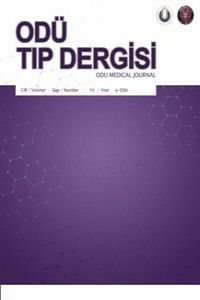Ankilozan Spondilitte Hastalık Aktivitesi ve Obezitenin Kinezyofobi Üzerindeki Etkisi
Ankilozan Spondilit, vücut kitle indeksi, hastalık aktivitesi, kinezyofobi
The Impact of Disease Activity and Obesity on Kinesiophobia in Ankylosing Spondylitis Kinesiophobia and Ankylosing Spondylitis
: Ankylosing Spondylitis, body mass index, disease activity, kinesiophobia,
___
- 1. Braun J, Sieper J. Ankylosing spondylitis. Lancet. 2007;369(9570):1379-1390.
- 2. Dougados M, Dijkmans B, Khan M, Maksymowych W, van der Linden S, Brandt J. Conventional treatments for ankylosing spondylitis. Ann Rheum Dis. 2002;61(Suppl III):40–50.
- 3. Luque-Suarez A, Martinez-Calderon J, Falla D. Role of kinesiophobia on pain, disability, and quality of life in people suffering from chronic musculoskeletal pain: a systematic review. Br J Sports Med. 2019;53(9):554-559.
- 4. Gorczyca R, Filip R, Walczak E. Psychological aspects of pain. Ann Agric Environ Med. 2013;20(1):23–7.
- 5. Keefe FJ, Rumble ME, Scipio CD, Giordano LA, Perri LCM. Psychological aspects of persistent pain: current state of the science. J Pain. 2004;5:195–211.
- 6. Severeijns R, Vlaeyen JWS, van den Hout MA, Weber WE. Pain catastrophizing predicts pain intensity, disability, and psychological distress independent of the level of physical impairment. Clin J Pain. 2001;17:165–72.
- 7. Sullivan MJL, Thorn B, Haythornthwaite JA, Keefe F, Martin M, Bradley LA, et al. Theoretical perspectives on the relation between catastrophizing and pain. Clin J Pain. 2001;17:52–64.
- 8. Alschuler KN, Hoodin F, Murphy SL, Rice J, Geisser ME. Factors contributing to physical activity in a chronic low back pain clinical sample: a comprehensive analysis using continuous ambulatory monitoring. Pain. 2011;152(11):2521-2527.
- 9. Lundberg M, Frennered K, Hägg O, Styf J. The impact of fear-avoidance model variables on disability in patients with specific or nonspecific chronic low back pain. Spine (Phila Pa 1976). 2011;36(19):1547-53.
- 10. Lamoth CJ, Meijer OG, Daffertshofer A, Wuisman PI, Beek PJ. Effects of chronic low back pain on trunk coordination and back muscle activity during walking: changes in motor control. Eur Spine J. 2006;15(1):23-40.
- 11. Altuğ F, Ünal A, Kilavuz G, Kavlak E, Çitişli V, Cavlak U. Investigation of the relationship between kinesiophobia, physical activity level, and quality of life in patients with chronic low back pain. J Back Musculoskelet Rehabil. 2016;29(3):527-31.
- 12. Oskay D, Tuna Z, Düzgün İ, Elbasan B, Yakut Y, Tufan A. Relationship between kinesiophobia and pain, quality of life, functional status, disease activity, mobility, and depression in patients with ankylosing spondylitis. Turk J Med Sci. 2017;47(5):1340-1347.
- 13. Braun J, Sieper J. Ankylosing spondylitis. Lancet. 2007;369(9570):1379-1390.
- 14. Dougados M, Dijkmans B, Khan M, Maksymowych W, van der Linden S, Brandt J. Conventional treatments for ankylosing spondylitis. Ann Rheum Dis. 2002;61(Suppl III):40–50.
- 15. Luque-Suarez A, Martinez-Calderon J, Falla D. Role of kinesiophobia on pain, disability, and quality of life in people suffering from chronic musculoskeletal pain: a systematic review. Br J Sports Med. 2019;53(9):554-559.
- 16. Gorczyca R, Filip R, Walczak E. Psychological aspects of pain. Ann Agric Environ Med. 2013;20(1):23–7.
- 17. Keefe FJ, Rumble ME, Scipio CD, Giordano LA, Perri LCM. Psychological aspects of persistent pain: current state of the science. J Pain. 2004;5:195–211.
- 18. Severeijns R, Vlaeyen JWS, van den Hout MA, Weber WE. Pain catastrophizing predicts pain intensity, disability, and psychological distress independent of the level of physical impairment. Clin J Pain. 2001;17:165–72.
- 19. Sullivan MJL, Thorn B, Haythornthwaite JA, Keefe F, Martin M, Bradley LA, et al. Theoretical perspectives on the relation between catastrophizing and pain. Clin J Pain. 2001;17:52–64.
- 20. Alschuler KN, Hoodin F, Murphy SL, Rice J, Geisser ME. Factors contributing to physical activity in a chronic low back pain clinical sample: a comprehensive analysis using continuous ambulatory monitoring. Pain. 2011;152(11):2521-2527.
- 21. Lundberg M, Frennered K, Hägg O, Styf J. The impact of fear-avoidance model variables on disability in patients with specific or nonspecific chronic low back pain. Spine (Phila Pa 1976). 2011;36(19):1547-53.
- 22. Lamoth CJ, Meijer OG, Daffertshofer A, Wuisman PI, Beek PJ. Effects of chronic low back pain on trunk coordination and back muscle activity during walking: changes in motor control. Eur Spine J. 2006;15(1):23-40.
- 23. Altuğ F, Ünal A, Kilavuz G, Kavlak E, Çitişli V, Cavlak U. Investigation of the relationship between kinesiophobia, physical activity level, and quality of life in patients with chronic low back pain. J Back Musculoskelet Rehabil. 2016;29(3):527-31.
- 24. Oskay D, Tuna Z, Düzgün İ, Elbasan B, Yakut Y, Tufan A. Relationship between kinesiophobia and pain, quality of life, functional status, disease activity, mobility, and depression in patients with ankylosing spondylitis. Turk J Med Sci. 2017;47(5):1340-1347.
- 25. Er G, AngIn E. Determining the relationship of kinesiophobia with respiratory functions and functional capacity in ankylosing spondylitis. Medicine (Baltimore). 2017;96(29):e7486.
- 26. Alghamdi NH, Pohlig RT, Lundberg M, Silbernagel KG. The Impact of the Degree of Kinesiophobia on Recovery in Patients With Achilles Tendinopathy. Phys Ther. 2021;101(11):pzab178.
- 27. Vincent HK, Vincent KR, Seay AN, Hurley RW. Functional Impairment in Obesity: A Focus on Knee and Back Pain. Pain Med. 2011;12(5):427–439.
- 28. Bakirci S, Dabague J, Eder L, McGonagle D, Aydin SZ. The role of obesity on inflammation and damage in spondyloarthritis: a systematic literature review on body mass index and imaging. Clin Exp Rheumatol. 2020;38(1):144–148.
- 29. Vincent HK, Seay AN, Montero C, Conrad BP, Hurley RW, Vincent KR. Kinesiophobia and fear-avoidance beliefs in overweight older adults with chronic low-back pain: relationship to walking endurance--part II. Am J Phys Med Rehabil. 2013;92(5):439-445.
- Yayın Aralığı: Yılda 3 Sayı
- Başlangıç: 2014
- Yayıncı: Ordu Üniversitesi
Zeynep KÜÇÜKAKÇALI, İpek BALIKÇI ÇİÇEK
Ankilozan Spondilitte Hastalık Aktivitesi ve Obezitenin Kinezyofobi Üzerindeki Etkisi
Elif ALTUNEL KILINÇ, Gizem KIRMIZIER, Nurdan ORUÇOĞLU
Geriatrik Hastalarda Kronik Yara Yönetimi; Bir Evde Sağlık Hizmetleri Örneği
Arzu AYRALER, Muhammed Emin GÖKTEPE, Aslı DİKMEN, Ceren VARER AKPINAR
Ultraviyole Işınlardan Korunma ve Güneş Gözlüğü ile İlgili Bilgi, Tutum ve Davranışların İncelenmesi
Bingöl'deki Aktarlarda Satılan Bazı Tıbbi Bitkilerin Besin Madde İçeriklerinin Belirlenmesi
